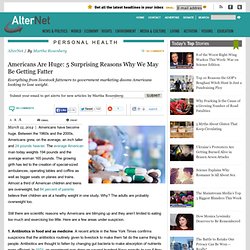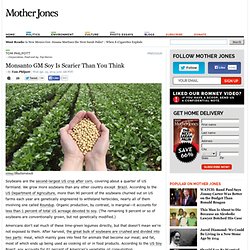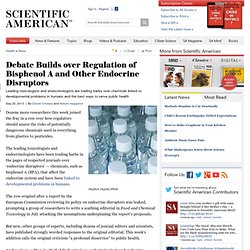

Americans Are Huge: 5 Surprising Reasons Why We May Be Getting Fatter. March 12, 2014 | Like this article?

Join our email list: Stay up to date with the latest headlines via email. Americans have become huge. Monsanto GM Soy Is Scarier Than You Think. Soybeans are the second-largest US crop after corn, covering about a quarter of US farmland.

We grow more soybeans than any other country except Brazil. According to the US Department of Agriculture, more than 90 percent of the soybeans churned out on US farms each year are genetically engineered to withstand herbicides, nearly all of them involving one called Roundup. Organic production, by contrast, is marginal—it accounts for less than 1 percent of total US acreage devoted to soy.
(The remaining 9 percent or so of soybeans are conventionally grown, but not genetically modified.) Americans don't eat much of these lime-green legumes directly, but that doesn't mean we're not exposed to them. Given soy's centrality to our food and agriculture systems, the findings of a new study published in the peer-reviewed journal Food Chemistry are worth pondering. The researchers found residue levels hovering above a level Monsanto itself has characterized as "extreme.
" 7 horrifying truths about your chicken dinner. This article originally appeared on Alternet.

Could there be anything worse for the chicken industry than this month’s outbreak of an antibiotic-resistant strain of salmonella that hospitalized 42 percent of everyone who got it—almost 300 in 18 states? Yes. The government also announced that China has been cleared to process chickens for the US dinner plate and that all but one of arsenic compounds no one even knew they were eating have been removed from US poultry production. Thanks for that. Also this month, some food researchers have revealed the true recipe for chicken “nuggets”…just in time for Halloween. Many people have decided to eat only chicken to avoid the health, environmental, worker and humane questions surrounding red meat. Infographic: Just How Dangerous Is The Dye In Your Food? They used to put cocaine in Coca Cola.

Vegetables were once routinely covered in deadly DDT. Ever wonder what poisons you eat that will make future generations look back in horror? In case you need something new to worry about, the answer could be food dyes, as a new infographic by SpecialEducationDegrees.net illustrates. Titled “Colors to Die for: The Dangerous Impact of Food Coloring,” a liquid black skull introduces a rainbow of toxins found in foods Americans eat every day. These dyes can cause everything from chromosomal damage to hyperactivity to brain tumors to eczema.
Arsenic Nation - Wired Science. For my New York Times column, Poison Pen, I wrote this week about arsenic in drinking water, or more specifically on the increasing scientific awareness that this element - odorless, tasteless – is slowly being revealed as major public health threat.

The focus of that piece is the way that arsenic, in the part-per-billion level, is able to undermine basic health, from immune system damage to corrosive effects on cells. Caffeine consumption slows down brain development, rat study shows. Humans and other mammals show particularly intensive sleeping patterns during puberty.

The brain also matures fastest in this period. But when pubescent rats are administered caffeine, the maturing processes in their brains are delayed. This is the result of a study supported by the Swiss National Science Foundation (SNSF). Children's and young adults' average caffeine consumption has increased by more than 70 per cent over the past 30 years, and an end to this rise is not in sight: the drinks industry is posting its fastest-growing sales in the segment of caffeine-laden energy drinks. Debate Builds over Regulation of Bisphenol A and Other Endocrine Disruptors. Dozens more researchers this week joined the fray in a row over how regulators should assess the risks of potentially dangerous chemicals used in everything from plastics to pesticides.

The leading toxicologists and endocrinologists have been trading barbs in the pages of respected journals over ‘endocrine disruptors’ — chemicals, such as bisphenol A (BPA), that affect the endocrine system and have been linked to developmental problems in humans. The row erupted after a report by the European Commission reviewing its policy on endocrine disrupters was leaked, prompting a group of researchers to write a scathing editorial in Food and Chemical Toxicology in July attacking the assumptions underpinning the report’s proposals.
But now, other groups of experts, including dozens of journal editors and scientists, have published strongly worded responses to the original editorial. This week's addition calls the original criticism “a profound disservice" to public health. Anxiety In Your Head Could Come From Your Gut. Dr.

James Greenblatt, a Boston-area psychiatrist, had a puzzling case: a teenager arrived in his office with severe obsessive–compulsive disorder (OCD), as well as attention deficit hyperactivity disorder (ADHD) and an array of digestive problems. What You Need to Know About the Toxins in Your Groceries. The cans of baby formula invaded Brian Jackson’s Dartmouth College lab late in 2010.

His team picked up an armful of popular brands at the food co-op in Hanover, N.H. Then another armload. Eventually Jackson had a cabinet full of the brightly labeled canisters.